#1967 Dodge Polara Sedan
Text

1967 Dodge Polara Sedan
#1967 Dodge Polara Sedan#usdm#patina#rat style#fitment#static#60s classic cars#vintage car#stance#modified#tuning#retro rides#tuner#slammed#street#lowered
57 notes
·
View notes
Text
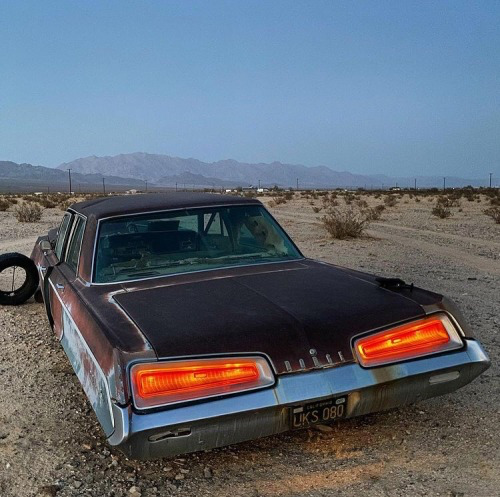
1967 Dodge Polara Sedan
54 notes
·
View notes
Text
Nomes iguais, carros diferentes
O Maverick nos anos 1950, a Kombi soviética, o Land Cruiser da Studebaker, o Miura italiano… Conheça alguns automóveis homônimos, mas com muito pouco em comum entre si
POLARA


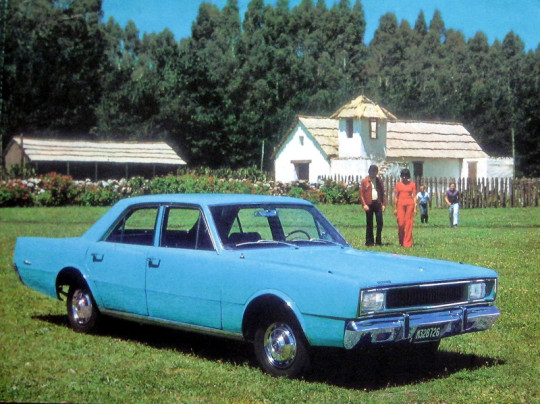
Americano, brasileiro e argentino
O primeiro Dodge Polara começou a ser fabricado nos Estados Unidos em 1960 e sua produção durou até 1973, quando o modelo foi substituído pelo Monaco. Era um sedan que concorria com o Galaxie, da Ford e o Impala, da Chevrolet.
Em comum com nosso pequeno Polara, apenas no nome mesmo. Esse era baseado no inglês Hilmann Avenger e foi fabricado entre 1973 e 1981. No inicio chamado de Dodge 1800, sendo rebatizado de Polara a partir de 1977.
Houve ainda um terceiro Polara, na Argentina, que era baseado no Dart americano 1967/1969, mas com design exclusivo.
RANGER


Edsel Ranger e Ford Ranger
Modelo de entrada da recém criada Divisão Edsel da Ford, o automóvel Ranger teve vida curta, sendo fabricado entre 1958 e 1960. Compartilhava a plataforma mais curta e estreita com alguns modelos Ford.
Em pick-ups, o nome Ranger apareceu pela primeira vez em 1963, como uma versão da Série F americana. Virou modelo mesmo só em 1983.
Já a Ford Ranger com a qual os brasileiros estão mais familiarizados chegou à América do Sul em 1995 (segunda geração), passando a ser fabricada na Argentina em 1998.
MAVERICK
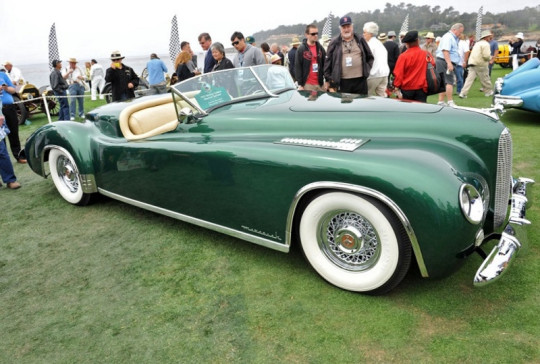
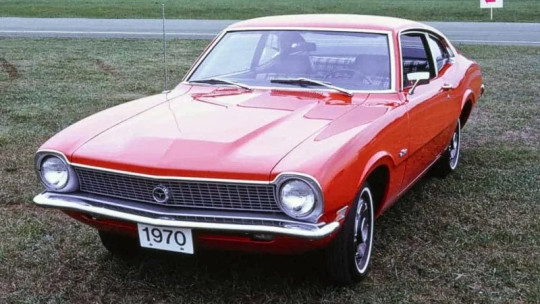
Sterling Maverick Roadster e Ford Maverick
O Maverick como o conhecemos é uma criação da Ford e teve sua produção iniciada no Estados Unidos 1969 nos Estados Unidos e uma versão brasileira (1973/1979) muito cultuada pelos antigomobilistas.
No entanto, o nome Maverick foi usado num automóvel pela primeira vez nos anos 1950, por uma pequena e desconhecida indústria chamada Sterling. O enorme Speedster tinha chassi e mecânica Cadillac e carroceria em fibra de vidro. Foram fabricados apenas sete e se sabe o paradeiro de apenas um, esse verde 1952 da foto.
COURIER
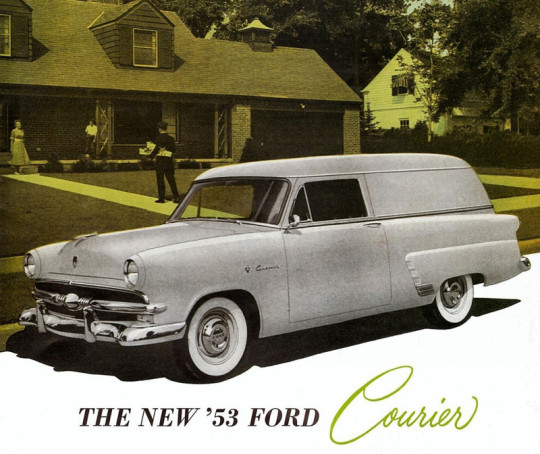
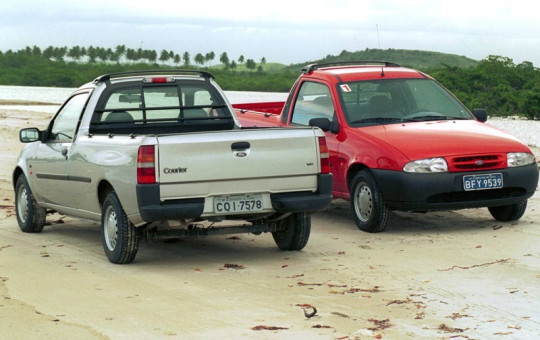

Courier americana, brasileira e a da Mazda
A pick-up Ford Courier que conhecemos aqui no Brasil em nada se parece com o modelo que inaugurou esse nome, em 1952. Era um furgão de entregas baseado nas Station Wagons Ford da época, cujos vidros laterais traseiros eram substituídos por chamas de metal.
Já a brasileira era uma pick-up compacta baseada no Fiesta e foi produzida de 1997 a 2013.
Entre as décadas de 1970 e 90, a Ford Americana ‘emprestou’ à japonesa Mazda a marca Courier para a produção da uma pick-up Mazda Série B, que foi vendida na Ásia e chegou a ser importadas para os EUA.
RENEGADE
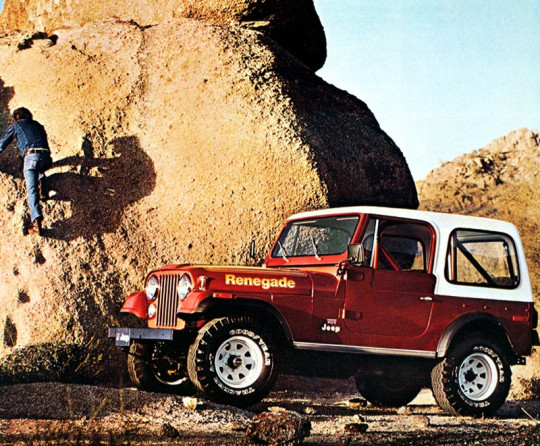
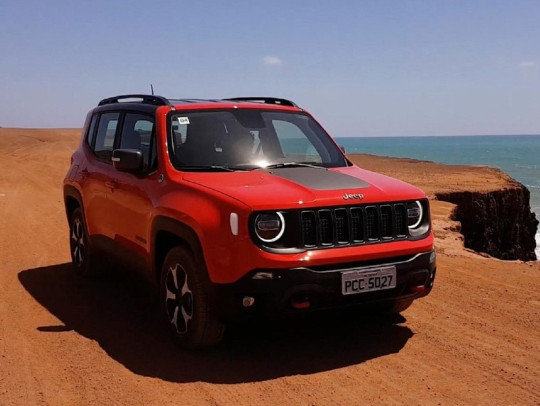
Antes de virar SUV, o nome Renegade foi usado no CJ5 e CJ7
O SUV que tanto sucesso nas ruas do Brasil e do Mundo nos dias de hoje tem um antepassado dos anos 1970. Era uma versão esportiva dos Jeeps CJ5 e CJ7 americanos e que infelizmente nunca chegaram ao Brasil. Na época, a marca hoje controlada pela Fiat-Chrysler pertencia à extinta American Motors (AMC).
GORDINI


Gordini brasileiro e francês, ambos Renault
O Gordini brasileiro foi fabricado de 1963 a 1968, pela Willys, sob licença da francesa Renault. No entanto, tratou-se apenas de uma variante do Dauphine, modelo que chegou aqui em 1959 e que recebeu melhorias mecânicas, ficando mais potente e consequentemente mudando de nome por questões de marketing.
Mas o Dauphine sempre manteve seu nome original na França e nos demais países onde foi fabricado ou montado, entre eles Itália, Espanha, Argentina, Nova Zelândia e Israel (embora tenha havido na França uma versão batizada Dauphine Gordini).
No entanto o Renault Gordini francês foi outro carro. Era a versão esportiva do R8, lançada em 1964, com motor de 1.108cc e 50hp; passando 1.255cc e 99hp em 1967. O R8 Gordini venceu várias provas de rally na Europa.
KOMBI


O mundialmente conhecido modelo VW teve um homônimo soviético
Kombi. Este veículo multiuso da Volkswagen — sucesso no mundo, principalmente no Brasil — dispensa apresentações.
Então vamos falar da outra Kombi. O Lada Vaz 2102 Kombi, que foi fabricado na antiga União Soviética 1970 e 1984. Tinha motores de 1.200 e 1.500cc. Era a variant Station Wagon do sedan 2101. Em alguns países a grafia era com ‘C’ (Combi). O modelo evoluiu e chegou ao Brasil em 1990 como Lada 2104 Laika SW.
MIURA


O superesportivo Lamborghini teve um homônimo no Brasil
O touro bravo da italiana Lamborghini nasceu em 1967 e foi o primeiro superesportivo da marca com mais de 300cv de potência. Projeto conjunto de Dallara e Bertone, o Lamborghini Miura tinha como principal característica visual os ‘silios’ que envolviam os faróis das primeiras versões. Foi fabricado até 1973, quando deu lugar a outro modelo famoso: o Countach.
Quatro anos depois, surgia no Rio Grande do Sul o nosso touro bravo, o Miura Sport, que usava a velha fórmula adotada para a grande maioria dos foras-de-série brasileiros: motor VW boxer refrigerado a ar e carroceria em fibra de vidro. Modelos posteriores passaram a usar motor VW AP dianteiro. Foram ao todo 12 modelos até 1992.
MATADOR
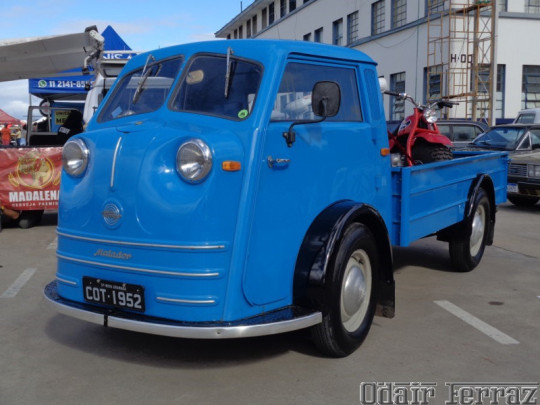

Tempo Matador Pick-up e a versão fastback esportiva do Matador da American Motors
Nome estranho para um carro! Mas Matador foi nome de dois modelos, um alemão e um americano. O primeiro foi fabricado pela Tempo entre 1949 e 1952 nas versões pick-up e furgão e usava o mesmo motor refrigerado a ar do Fusca, então com potência de 1.100cc.
O segundo Matador foi um modelo de luxo fabricado nos EUA pela American Motors (AMC) entre 1971 e 1978. Teve duas gerações e versões sedan, coupê e station Wagon.
MONZA

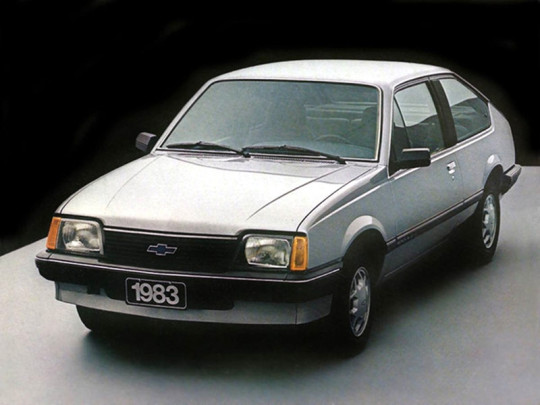
Chevrolets Monza, de lá e de cá
Apesar de ambos serem Chevrolet, o Monza norte-americano nada tem a ver com o brasileiro. É que o nosso não é baseado em nenhum modelo dos Estados Unidos, mas sim no Opel Ascona, que nasceu na Alemanha. Embora, como se sabe, até 2017 a Opel tenha sido uma subsidiária da GMC na Europa. Hoje pertence ao Grupo PSA.
O Monza Norte Americano foi um compacto produzido entre 1975 e 1980, cuja linha incluía coupês e hatchbacks, com modelos bem distintos entre si. Já o Brasileiro estreou no mercado em 1982 e permaneceu até 1996, com duas gerações.
LAND CRUISER


O longevo Sedan Land Cruiser Studebaker e o jipe da Toyota, que no Brasil foi rebatizado de Bandeirante
Talvez você não esteja ligando o nome ao carro. Mas o Land Cruiser foi muito popular no Brasil e até hoje é fácil vê-lo em nossas cidades, quase sempre fazendo trabalhos pesados. Fabricado pela Toyota, esse quase indestrutível utilitário teve por algum motivo seu nome abrasileirado para Bandeirante. Foram fabricadas só aqui mais de 100 mil unidades ao longo de 43 anos. Isso mesmo! O Toyota Bandeira é o vice-campeão dos nacionais que mais tempo ficou em produção: de 1958 a 2001! Só perde mesmo para a Kombi, que durou 56 anos.
No Japão, o Land Cruiser evoluiu e hoje a Toyota fabrica com esse nome um moderníssimo SUV, que em alguns países tem a marca Lexus.
Mas antes desses dois japoneses, houve outro Land Cruiser: um longevo sedan da extinta marca Studebaker, produzido por 20 anos a partir de 1934. Pelo jeito o nome Land Cruiser dá sorte!
Conhece outros carros homônimos? Então nos avise, que vamos fazer a segunda parte desse matéria. Use o espaço dos comentários.
Texto e edição: Fernando Barenco
.fb_iframe_widget_fluid_desktop iframe {
width: 100% !important;
}
O post Nomes iguais, carros diferentes apareceu primeiro em Maxicar – Carro antigo, pura nostalgia..
Nomes iguais, carros diferentes publicado primeiro em https://www.maxicar.com.br/
4 notes
·
View notes
Photo
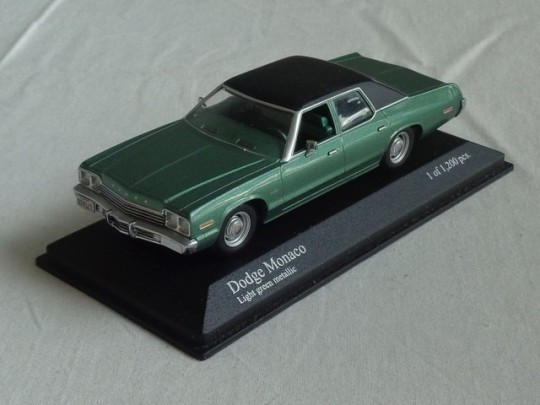



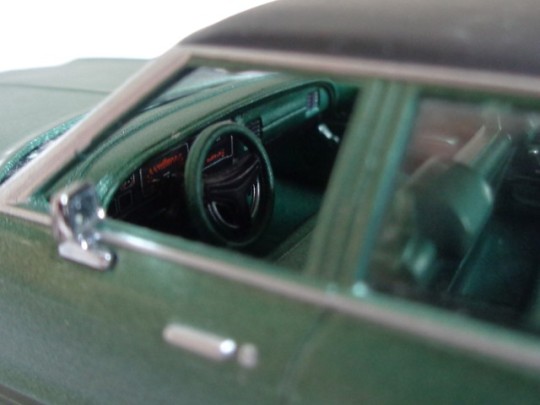

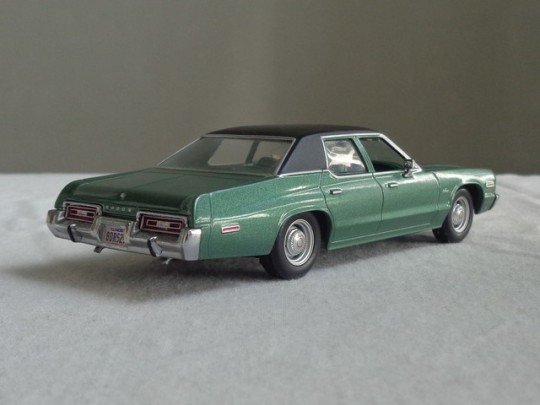

1974 Dodge Monaco (Minichamps 1:43)
The Monaco was originally introduced in 1965 as a ”Limited Edition” of Dodge's full size Custom 880 model, intended to compete with Pontiac's Grand Prix in the personal luxury car segment. But this plan was jettisoned the very next year when the Monaco actually went on to replace the Custom 880 entirely, with the previous ”special” Monaco now being given the upper scale badging of the Monaco 500 in separation from the base model. A major facelift followed in 1967, while a wholly new ”fuselage” style redesign for 1969 came to signify its transitioning to its second generation lineup that lasted until 1973. At this juncture, Chrysler were looking to revamp their full-size model lineup of the Dodge Monaco and Plymouth Fury to their new C-Body configuration, which was to feature all new sheetmetal and a new unibody construction.
Unfortunately, only days after their introduction, the 1973 oil crisis began and suddenly large cars like the Monaco were seen as being wasteful and out-of-touch with the times as people were rather gravitating toward smaller, more economical compacts instead. The media subsequently eviscerated them for their size and uninspired styling, while sales suffered accordingly. However, they did still find great favour as fleet cars, particularly with the police force, and this would not see a change during the entirety of the Monaco's existence. This new third generation Monaco also came to replace the older Polara model that had been in production since 1960, with the Monaco lineup now consisting of three trim levels: basic, Custom, and the upper scale Brougham. Engine options consisted of a 2-barrel 360 cid V8 as standard, a 360 with a 4-barrel carburetor, a 2- or 4-barrel 400 cid plant, or a 4-barrel 440 cid engine. Available body styles consisted of a two-door coupe, a four-door sedan, a 4-door hardtop for this year only, and a station wagon with optional faux-wood side trim.
The Custom and Brougham trims, however, ended up being both eliminated in 1975 and subsequently replaced by the separate Royal Monaco model, easily identifiable through their headlight covers and different grille, while a further ”Diplomat” option was offered on two-door Brougham coupes featuring a landau vinyl roof, an opera window, and a wide steel band to separate the vinyl section from the rest of the roof. On a downside, this was also the year when the catalytic converter was introduced, designed to minimse car emissions in order to adhere to ever tightening emissions regulations, though this also meant the loss of horsepower and fuel economy due to the restrictions in the free flow of exhaust. The C-Body Monaco would countinue in this form until 1976 when it was downsides to the B-Body platform for 1977, though the Royal Monaco still remained in production for 1977 on its old C-Body platform before being discontinued entirely for the following year. This state of affairs, though, would not last long as the Monaco name itself was subsequently discontinued after 1978, with the nameplate only revived for a short time between 1989 and 1992 for the rebadged Eagle Premier.
By all intents and purposes, the 1974-1977 Monaco/Royal Monaco can't really be called a stupendous car on any level, being effectively just a really big, boxy 1970s sedan with not much flair and not much in terms of styling finesse of the 1965-73 models. But it has earned a spot in popular culture nevertleless when a '74 ex-police cruiser was used as the hero car in the cult classic ”The Blues Brothers” where it came to perform increasingly strange and over-the-top stunts to confuddle the army of cops chasing after the hapless musicians on a mission from God. The same film also featured a large amount of other police Monacos and Royal Monacos that were summarily trashed in the multitude of car chases the movie was filled to the brim with. It lent the car a cool factor that quite frankly otherwise isn't there and for that has carved itself into a strange, but endearingly oddball place in many people's hearts... including mine.
Due to the Monaco being so prevalent as a cop car in various movies and TV shows, this has also resulted in there being an influx of scale models being produced of the C-Body Monaco by various different manufacturers, often in connection to one of these movies or shows. But in terms of providing standard versions of the car, only Minichamps thus far has seen fit to also provide regular Monaco variants for purchase. And they certainly have taken full advantage of maximising the use of this model as they have not only provided three colour variants on the base sedan (green with black top, brown with black top, and blue), but have also made a highway patrol, taxi and fire department versions for those preferring the fleet car approach for this big Dodge. Of these versions available, my favourite is the above green variant (official colour name ”Frosty Green”) that combines the black vinyl top with a more attractive colour choice than the alternative vomit brown.
As a minituarised representation of the 1974 Dodge Monaco there is very little to criticise, with Minichamps' usual quality standards making for perhaps the best scale model of this particular car available by anyone in any scale. Only the lack of colour for the grille embedded in the bumper (which I have coloured in myself here) stands as a notable gripe in regards to the model's accuracy. The interiors are all colour keyed with the exterior, which works fine even with the threat of making everything look a bit monotonous in terms of contrast, while the dash gauches are clearly printed on a sticker, though that's hardly atypical of any model to be considered as a complaint of any kind. The bottom of the car is nicely detailed with separate exhaust pipes and coloured oil pan to add that bit of texture, while dimension-wise everything is spot on and the casting is both sharp and well-defined. So, in terms of recommending a '74 Monaco at the 1:43 scale, there is little to detract from the Minichamps offering unless you specifically want a Bluesmobile replica or somesuch, in which case the highly affordable Greenlight model would likely suit you better. For a base Monaco, though, this is really your only bet in town. 5/5
Variant break-downs:
Light Green Metallic: 1,200 pieces
Gold Metallic: 1,008 pieces
Luceme Blue Metallic: 1,680 pieces
Taxi: 1,008 pieces
Fire Department: 1,008 pieces
Highway Patrol: 1,008 pieces
1 note
·
View note
Text
HUMONGOUS Gallery Of Mopar Readers Rides!
The results are in and the photos sent in by Mopar Muscle readers around the world are awesome. From the get-go, we got piles of packages of pristine Pentastars and at times we thought the deluge would never end. When the June 17, 2017 deadline finally arrived, we had amassed well over 100 entries, proving that at the end of the day, print magazines still rule, and getting on the newsstand trumps being buried in a Facebook feed any day. Disagree? Next time you go to a show, see how many cars display posters with magazine stories of their car in print.
If you sent in pix of your pride and joy and followed our simple guidelines, there’s a 98 percent chance your car made it into the story. That said, we had to make some tough decisions at times, such as limiting the number of cars submitted per reader to just two. (Yes, we know some of you are prodigious collectors!) There were also technical reasons some didn’t get in, like you forgot to hit the “burn” button on your cd, or you forgot to submit a tech sheet with a signed affidavit attesting you were the photographer. (And while we’re at it, at least one of you doesn’t know which way you want to spell your own name.) One person even sent in their entry two weeks after the deadline. Sorry pal! You had over five months to get it together!
Some of the images are truly breathtaking, making it hard to pick the best. What we noticed is that some of you are quite adept at expressing the shape, stance, and personality of your Mopars. This is not uncommon. You may have drawn Mopars as a bored kid sitting in math class, or you may have spent hundreds of hours smoothing body panels for paint—the fact is, you know the lines that drive you crazy, and you found a way to succinctly capture that. Thanks for taking the time to show us—through your eyes—what you see when you look at your machine.
In the end though, we had to go with the amazing work of 40-year-old Brian Turney (San Diego, CA), who knocked us over with pix of his 2006 Dodge Magnum SRT8. Brian has apparently been paying rapt attention to some of the best automotive photographers on the planet, as he combined his eye for detail, composition, and lighting with competencies in lensmanship and photo illustration. Congratulations to Brian on a job well done. We hope he enjoys his grand prize of $800 worth of Auto Meter Custom Shop gauges!
Grand Prize: Auto Meter Custom Shop Gauges
Until recently, only the most lavishly equipped machines on the show car circuit had one-off instrumentation. Then Auto Meter came up with a great idea: set up a custom shop for gauges so that anybody could get exactly what they want. The Auto Meter Custom Shop lets customers design their own gauges with unique color faces, ticking, pointers, cover glass, fonts, bezels, and lighting. If it’s part of a gauge, the Auto Meter Custom Shop can do it for you. After logging on to the Auto Meter Custom Shop website, download the Custom Shop configurator, and start picking out your gauges with all the features you want. As you build your dream gauge package, the gauges take shape right on the screen. You can try out several different designs, save them for future reference, or compare them. You can even print them out and try them in your car before ordering. And all while you’re building your virtual gauges, the cost is updated and displayed with every revision. You’ll also be quite surprised how affordable it is; when compared to a standard set of catalog gauges, it’s only a few extra bucks. Once you order them, they’ll show up at your door in a beautiful handcrafted wood box. They look so nice, you won’t even want to put them in your car!
WINNER!
2006 Dodge Magnum SRT8 | Brian Turney; San Diego, CA
“Pam The Demon Wagon” is the name Brian Turney—an IT manager from San Diego—has given to his 2006 Dodge Magnum SRT8. Brian has been a Mopar guy ever since he was four months old, which coincides with his parents buying a new 1977 Dodge Aspen station wagon. That car would later accompany him to college almost two decades later. His current car, the SRT8 Magnum, is the Aspen wagon’s spiritual incarnation. Brian writes: “In 2014, I was driving down the Coast Highway in San Diego and I ended up behind a Dodge Magnum SRT8. Memories of my Aspen wagon came back to me. I decided it was time to get another wagon and started shopping for one. I found one on Auto Trader being sold by a private seller. During the test drive, I was hooked. After coming to an agreement on price, I took one last look at her in the garage as I walked away. That’s when I saw the license plate frame, which said ‘Kimi’s Hemi.’ This was the exact car I had seen a few weeks prior on the Coast Highway! It was meant to be.” Brian has kept the 425hp 6.1L Hemi all stock, except for a Borla exhaust.
On the photography side of things, Brian is a bit of a self-professed nerd. Besides driving his SRT8, Brian loves photography, and has put his Canon 5D Mark II and L-Series zoom lens to good use. On the post side, Brian uses Adobe Photoshop and Lightroom to amp up the emotion and deepen the mystery. We would put his photography and Photoshop chops on par with our best contributors—our only gripe (and it’s a small one) being that he needs to increase his depth of field and lower the ISO (to reduce noise) just a tad.
RUNNER UP
1970 Dodge Charger R/T | Kevin Quirk | Netcong, NJ
RUNNER UP
1966 Dodge Coronet 500 | Alexis Piantieri | Northridge, CA
RUNNER UP
1968 Plymouth Barracuda | John Byler | Blue Springs, MO
RUNNER UP
1963 Plymouth Sport Fury | Russ Hess | Port Orange, FL
2015 Dodge Challenger | Duane Springer | Rowland Heights, CA
1977 Chrysler Cordoba | Colin Valentim | Logan Lake, British Columbia
1978 Chrysler LeBaron | Colin Valentim | Logan Lake; British Columbia
1973 Dodge Challenger | Randy Wynn | Boulder City, NV
1971 Dodge Power Wagon | Mark J. Polk | Harrells, NC
2009 Dodge Challenger R/T | Wayne R. Boyd | Little Egg Harbor Twsp., NJ
1968 Plymouth Road Runner | Tony Mannella | Petaluma, CA
1968 Plymouth Custom Suburban | Mark Childs | Tigard, OR
1971 Plymouth Duster | Steve Nitti | Scandia, MN
1973 Plymouth Duster | Todd Shaw | Mckinleyville, CA
1970 Plymouth Road Runner | Tom Papez | West Bend, WI
1965 Dodge Dart GT Convertible | Mark Thiltgen | Bloomington, MN
1965 Plymouth Belvedere II Convertible | Timothy Seymore | Cresson, PA
1962 Plymouth Fury | John Ingalls | Wellston, OH
1972 Dodge Demon | Rick Buck | Maquoketa, LA
1966 Dodge Charger | Cameron D. Moore | Auburn, IN
1967 Dodge Dart GT | Shannon Hebert | Dickinson; TX
1967 Plymouth Hemi GTX | Kaitlyn Blanc | Culpeper, VA
1965 Plymouth Barracuda | Wayne Briere | Cameron, Ontario
2015 Dodge Challenger SRT Hellcat | John Richmond | Dorado Hills, CA
1973 Dodge Charger Rallye | Thomas Pedergnana | Evergreen Park, IL
1969 Dodge Coronet | Tom Muellenbach | Malone, WI
1962 Dodge Dart | Michael A. Paipal | Oakdale, MN
1967 Dodge Charger | John Blaesi | Ochelata, OK
1967 Plymouth GTX | Dennis Lauver | Harrisburg, PA
1970 Plymouth ’Cuda | Dennis Lauver | Harrisburg, PA
1990 Dodge Dayton RWD Conversion | Tom Allard | Fayetteville, NC
1969 Dodge Dart | Derek Daniels | Tucson, AZ
1969 Dodge Dart Swinger | Rick Jones | Victoria, TX
1971 Plymouth ’Cuda | Jeff Duckworth | Derby, KS
1965 Plymouth Belvedere I | Bob Macaluso | Webster, NY
1976 Chrysler Cordoba | Matt Johnson | Vancouver, WA
1965 Plymouth Satellite | Paul Kinzer | Louisville, KY
1970 Dodge Charger R/T | Don Leskovar | Butte, MT
1970 Dodge Coronet Super Bee | Randy Rohde | LaVernia, TX
1965 Plymouth Belvedere II | Nick Godat | Hermann, MO
1970 Plymouth Road Runner | Darren Dearth | Weymouth, MA
1970 Plymouth Road Runner | Rick Tetrault | Grande Pointe, Ontario
1987 Dodge W150 Power Wagon | Marlin Stenger | Brookville, IN
1980 Dodge Mirada | Kevin Bollinger | Lebanon, PA
1969 Dodge Dart | Roger Fossett | Fort Worth, TX
1968 Dodge Coronet | Chris Krull | Vandalia, OH
1966 Plymouth Belvedere II | Frank Pavia | Webster, NY
2016 Dodge Challenger R/T | Randy Tucker | Spokane, WA
1978 Dodge D150 Warlock | Baron Leap | Hyndman, PA
1971 Plymouth Barracuda | Charles Morris | Richardson, TX
1970 Dodge Challenger SE | Glenn Heimbigner | Liberty Hill, TX
2016 Dodge Challenger Scat Pack | Kurt Schacher | Stockton, CA
1971 Dodge Charger | Steve Brock | Myrtle Beach, SC
1970 Dodge Charger | Nicholas Ours | Mentor, OH
1965 Dodge Coronet 440 | Randy Durham | Hot Springs, AR
1962 Dodge Polara 500 | Dave Loughner | Greensburg, PA
1968 Chrysler 300 Convertible | Ted Bordvin | Grand Rapids, MI
1967 Dodge Dart GT | Richard Gilbert | Willoughby, OH
1968 Plymouth Barracuda Formula S | Vincent Pattison | Dear, DE
1969 Dodge Coronet Convertible | Paul Kerl | Lorton, VA
1968 Plymouth Belvedere | Eddie Streeter | Crestwood, KY
1969 Plymouth Road Runner | Bob Melhorn | Fisherville, KY
1971 Dodge Challenger R/T | David Roma | Chichester, NH
1968 Plymouth Valiant 100 | Josh Holsopple | Everett, WA
1967 Plymouth Sport Fury Convertible | Steve Goldsmith | Floral Park, NY
1936 Plymouth P2 Coupe | Dean Rawson | Boise, ID
1970 Plymouth Fury Sedan | Gil Haas | Long Valley, NJ
1965 Plymouth Belvedere | William Udey | Port Orange, FL
1967 Plymouth Barracuda | Richard Ott | Santa Maria, CA
1973 Dodge Challenger Rallye | Mike Sanchez | Afton, WY
1968 Plymouth Road Runner | Frank Davis | Hackettstown, NJ
2010 Dodge Challenger R/T | Mike Perrino | Massapequa, NY
1967 Dodge Coronet | John Jadwisiak | Port Clinton, OH
1971 Dodge Charger | Jon Wilson | Atascadero, CA
1970 Plymouth ’Cuda | James Camerden | Colorado Springs, CO
1970 Dodge Challenger R/T | Michael Bollinger | Lebanon, PA
1974 Dodge Challenger | Richard Sheola | Long Valley, NJ
1973 Dodge Charger SE | Jared Reese | Goodsprings, NV
1969 Chrysler Newport Custom | Joseph Calise | Smithtown, NY
1970 Plymouth Barracuda Gran Coupe | Ed Madill | Glendale, AZ
1964 Chrysler 300 | Chuck Jackley | Terre Haute, IN
1971 Dodge Charger | Troy Tadlock | Billings, MT
1967 Plymouth Belvedere | Dwayne Gouw | Red Deer, Alberta
1967 Plymouth Barracuda | Jason Howe | Birdseye, IN
1967 Plymouth Barracuda Formula S | Raschel Adams | Benton, KY
1968 Dodge Dart | Paul Corvino | Deer Field, FL
1965 Plymouth Barracuda | Brian Mosel | Dublin, CA
1974 Plymouth Duster | Randy Kayser | Bosque Farms, NM
1972 Dodge Dart Swinger | Jens Kroeber | Lauchingen, Germany
2015 Dodge Challenger SRT Hellcat | Chad Feyerabend | Williamson, TN
1963 Plymouth Sport Fury | Lyle F. Donahew | Louisville, KY
1971 Plymouth Satellite Sebring | D. Millard-Hurst | Greentown, PA
2012 Dodge Challenger R/T | Joel Dalman | Hudsonville, MI
1969 Dodge Charger R/T | Jerry Klupp | Milwaukee, WI
1969 Plymouth Road Runner | Jack Bowen | Brentwood, CA
1970 Dodge Challenger | Rod Whaley | Melbourne, FL
1974 Dodge W100 Power Wagon | Kurt Hoffman | LaQuinta, CA
1969 Dodge Coronet Super Bee | Gary Michel | Iowa City, IA
2012 Dodge Challenger R/T | Larry Lippert | Walkerton, Ontario
1972 Dodge Charger R/T | Lloyd Rademacher | Portland, MI
1969 Plymouth GTX | Lou Vermette | Victoria, British Columbia
1969 Plymouth Road Runner | John Butler | Eugene, OR
1974 Dodge Charger | Terry Howe | Birdseye, IN
1970 Dodge Challenger Convertible | Herb Doyle | Little Neck, NY
13 Ways To Fail At The Mopar Muscle Photo Contest
From month to month, we typically feature cars that are extraordinary in some manner. Highlighting the best of the breed—whether that’s for customization, speed, rarity, ingenuity, or the perseverance of its owner—is the goal in light of the fact that we typically only have the resources to feature between 24 and 36 cars each year. That means a lot of folks don’t get into the magazine. To level the playing field and give the typical Mopar owner a chance, we’ve created the Photo Contest, which places the emphasis on your photography, not your car-building or income-earning prowess. We’ve lowered the bar so that theoretically at least everybody with decent eyesight and a smartphone can participate. Nevertheless, some find it difficult to hold a cellphone camera level and get the entire car in the shot. To keep guys on the right track, we even provided a list of photo tips to follow when shooting a car for a magazine. Those tips can be found in our original call-out introducing the Photo Contest here [Get Mopar Muscle Magazine Win Auto Meter Gauges]. Naturally, Mopar guys can be a stubborn breed. Who among us hasn’t laughed heartily while tossing out the instructions for installing or assembling an expensive piece of equipment? The same thing happened here. Forthwith, enjoy the failures depicted below, and please don’t take it too personally if you find your photo!
1. Chop the front (or back) of the car off. Heaven forbid you take a few steps backward to get the whole thing in.
2. Cars are like cattle, and are in their element driving through the pasture. Show them grazing on grass.3. Shoot into the sun with harsh back lighting and plenty of lens flare.
3. Don’t give the subject visual room to breathe. Crop the photo right to the edge.
4. Make large, strange objects grow out of the roof of the car. Helicopters, tanks, totem poles, flags—let ’em know Armageddon is coming!
5. Don’t wipe the pocket lint and sweat off your cellphone camera’s lens before you shoot. That would take too much time.
6. Looking for a large enough piece of pavement to shoot a car is such a hassle. Just roll it halfway off the road.
7. Turn it into a selfie and get your own shadow in the photo.
8. Tilt the camera at a crazy angle, then crop it so we can’t put the horizon straight again. Because keeping your lunch in your stomach is really overrated.
9. Make all your best shots vertical in the presumption it’s going to be the main cover of the magazine.
10. Drive your car into the swamp, or at least get the tires soggy at the edge. Again, this is a completely natural environment for a Mopar.
11. Crop the photo so flat, it can only be viewed through the rear window of a new Camaro.
12. Destroy a really great photo by setting the windows at weird openings, or leaving the quarter windows up on a convertible.
13. Spend 30 seconds taking your cellphone shots in harsh midday light, then spend half a day triple-wrapping your photo cd in bubble plastic, printing giant 8×10 pix at Staples, assembling your tech sheet and story in a hefty scrapbook, then pack it all carefully in a giant box with half a roll of packing tape.
The post HUMONGOUS Gallery Of Mopar Readers Rides! appeared first on Hot Rod Network.
from Hot Rod Network http://www.hotrod.com/articles/humongous-gallery-mopar-readers-rides/
via IFTTT
0 notes
Text
‘Carro do Ano’: saiba quais foram os eleitos desde 1966
Prêmio foi instituído no Brasil pela revista Auto Esporte. Corcel, Monza e Uno estão entre os tricampeões. Primeira ganhadora foi a Pick-up Willys
O Prêmio ‘Carro do Ano’ foi criado na Europa em 1964 pela Car of The Year Foundation e hoje conta com a participação de um júri formado pela imprensa especializada de 23 países.
No Brasil o ‘Carro do Ano’ nasceu em 1966 sob a batuta da revista Auto Esporte, que faz essa eleição até hoje. A partir da década de 1990, a escolha passou a considerar não apenas os automóveis fabricados no Brasil, mas também os importados. Atualmente, além da principal, a premiação tem várias outras categorias:
Carro Premium do Ano
Utilitário do Ano
Utilitário Premium do Ano
Carro Verde do Ano
Motor do Ano até 2.0
Motor do Ano Acima de 2.0
Site do Ano
Publicidade do Ano
Executivo do Ano
Hall da Fama Autoesporte
A fabricante do modelo eleito tem direito de usufruir do título de ‘Carro do Ano’ até o ano seguinte, quando acontece uma nova eleição.
Mas quais foram os modelos eleitos desde o nascimento do prêmio aqui no Brasil? Os critérios de escolha incluem diversos quesitos, como mecânica, estilo e acabamento. Mas o carro eleito é em geral um modelo lançado naquele ano, no ano anterior, ou que tenha passado por alguma evolução significativa recente. O ganhador de 1967, por exemplo foi o Ford Galaxie, lançado naquele ano. No ano seguinte não houve prêmio (não conseguimos descobrir o motivo). Em 1969 o título de ‘Carro do Ano’ foi para outro Ford, o Corcel, lançado em 1968.
Curiosamente o primeiro veículo a levar o título, em 1966, foi um utilitário: a espartana Pick-up Willys (depois rebatizada de Ford F-75).
Ao longo desses 53 anos, quatro modelos tiveram a honra de ser tricampeões: Ford Corcel — 1969, 1973 e 1979; Fiat Uno — 1985, 1992 e 2011; Fiat Palio — 2001, 2004 e 2012; e Chevrolet Monza — 1983, 1987 e 1988.
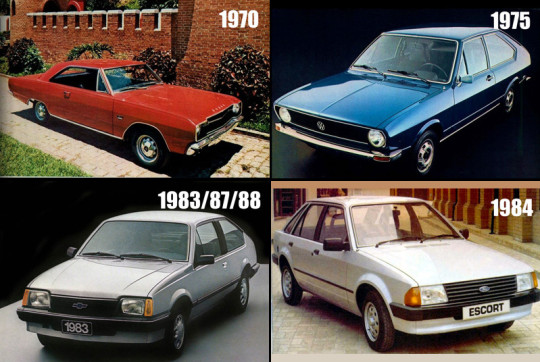
Os Eleitos
1966 – Pick-up Jeep Willys 1994 – Chevrolet Vectra 1967 – Ford Galaxie 1995 – Chevrolet Corsa 1968 – Não houve premiação 1996 – Chevrolet Corsa 1969 – Ford Corcel 1997 – Chevrolet Vectra 1970 – Dodge Dart 1998 – Ford Ka 1971 – VW TL 1999 – Fiat Marea 1972 – Chevrolet Opala 2000 – Audi A3 1973 – Ford Corcel 2001 – Fiat Palio 1974 – Chevrolet Chevette 2002 – Fiat Stilo 1975 – VW Passat 2003 – Fiat Stilo 1976 – Chevrolet Caravan 2004 – Fiat Palio 1977 – Dodge Polara 2005 – Ford Fiesta Sedan 1978 – Fiat 147 2006 – Fiat Idea 1979 – Ford Corcel 2007 – Honda Civic 1980 – VW Passat 2008 – Fiat Punto 1981 – Chevrolet Chevette 2009 – VW Gol 1982 – VW Voyage 2010 – Chevrolet Agile 1983 – Chevrolet Monza 2011 – Fiat Novo Uno 1984 – Ford Escort 2012 – Fiat Palio 1985 – Fiat Uno 2013 – Hyundai HB20 1986 – Fiat Premio 2014 – Volkswagen Golf 1987 – Chevrolet Monza 2015 – Ford Ka 1988 – Chevrolet Monza 2016 – Jeep Renegade 1989 – VW Santana 2017 – Honda Civic 1990 – VW Gol 2018 – Volkswagen Polo 1991 – Chevrolet Kadett 2019 – Volkswagen Virtus 1992 – Fiat Uno 2020 – Toyota Corolla 1993 – Chevrolet Omega
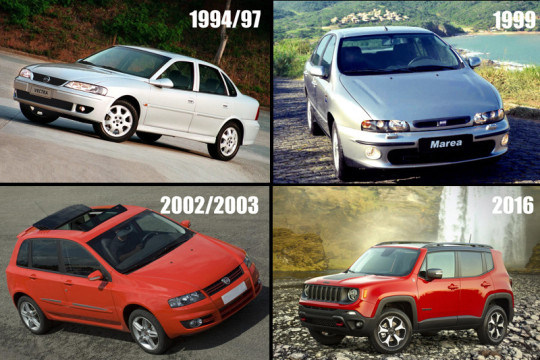
Texto e edição: Fernando Barenco
.fb_iframe_widget_fluid_desktop iframe {
width: 100% !important;
}
O post ‘Carro do Ano’: saiba quais foram os eleitos desde 1966 apareceu primeiro em Maxicar – Carro antigo, pura nostalgia..
‘Carro do Ano’: saiba quais foram os eleitos desde 1966 publicado primeiro em https://www.maxicar.com.br/
0 notes